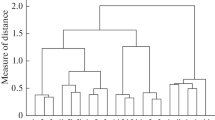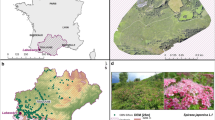Abstract
Abandonment of agriculture land and subsequent natural afforestation have been common features of the contemporary Latvian rural landscape, particularly in the period since 1990. This process affects the structure, ecology and visual qualities of the landscape. The study examines spatial characteristics of afforestation in relation to various environmental factors. The study was conducted in the central part of Latvia, where there is abundant abandoned agriculture land and a great variety of spatial afforestation patterns. The most typical patterns in this area were linear, mosaic, and continuous afforestation, as well as development of afforestation from the forest edge. The results of the study show that the spatial patterns of natural afforestation of abandoned agriculture fields can be very diverse, and do not follow the classical secondary succession model. Afforestation can be delayed by a dense cover of herbaceous vegetation for a period of up to 20 years. There are many interacting factors that affect succession and development of afforestation patterns, such as soil properties, size and configuration of fields, previous land use and also the random nature of plant colonization by seed. Further studies on afforestation patterns would help to understand better their ecological, economic and social effects as well as to determine optimal solutions for the use of abandoned agriculture land.




Similar content being viewed by others
Notes
Remote sensing images produced using digital camera Vexcel “UltraCamX” (216 megapixels), at the flight height of 7,000 m.
GPS—Magellan.
ICP—International Cooperation Programme.
GIS softwere ESRI Arc Map 9.2.
PCA softwere PC ORD 5.10.
References
Alard D, Chabrerie O, Dutoit T, Roche P, Langlois E (2005) Patterns of secondary succession in calcareous grasslands: can we distinguish the influence of former land uses from present vegetation data? Basic Appl Ecol 6:161–173
Alriksson A, Olsson MT (1995) Soil changes in different age classes of Norway spruce (Picea abies (l.) Karst.) on afforested farmland. Plant Soil 168–169:103–110
Antrop M (2005) Why landscape of the past are important for the future. Landsc Urban Plan 70:21–34
Armolaitis K, Aleinikoviene J, Baniūniene A, Lubyte J, Zekaite V (2007) Carbon sequestration and nitrogen status in arenosols following afforestation or following abandonment of arable land. Balt For 13(2):169–177
Bartha S, Meiners SJ, Pickett STA, Cadenasso ML (2003) Plant colonization windows in mesic old field succession. Appl Veg Sci 6:205–212
Bell S, Nikodemus O, Peneze Z, Kruze I (2009) Management of cultural landscapes: what does this means in the former Soviet Union? a case study from Latvia. Landsc Res 34:425–455
Benabdellah B, Albrecht KF, Pomaz VL, Denisenko EA, Logofet DO (2003) Markov chain models for forest succession in the Erzgebirge, Germany. Ecol Model 159:145–160
Benjamin K, Bouchard A, Domon G (2007) Abandoned farmlands as components of rural landscapes: an analysis of perceptions and representations. Landsc Urban Plan 83:228–244
Bürgi M, Hersperger AM, Schneeberger N (2004) Driving forces of landscape change—current and new directions. Landsc Ecol 19:857–868
Clements F (1936) Nature and structure of the climax. J Ecol 24:252–284
Connell JH, Slatyer RO (1977) Mechanisms of succession in natural communities and their role in community stability and organization. Am Nat 111:1119–1144
Daugaviete M (2009) The qualitative characteristics of naturally-developed deciduous forest stands in abandoned agricultural lands. In: Substantiation of deciduous trees cultivation and rational utilisation, new products and technologies. State Research Programme, 2005–2009. Proc Riga Latvian State Inst Wood Chem: 23–27 (in Latvian with English summary)
Egler FE (1954) Vegetation science concepts. I. Initial floristic composition—a factor in old-field vegetation development. Vegetatio 4:412–417
Falkengren-Grerup U, ten Brink DJ, Brunet J (2006) Land use effects on soil N, P, C and pH persist over 40–80 years of forest growth on agricultural soils. For Ecol Manag 225:74–81
Fjellstad WJ, Dramstad WE (1999) Patterns of change in two contrasting Norwegian agricultural landscapes. Landsc Urban Plan 45:177–191
Forest Soil Co-Ordinating Centre (2006) Manual IIIa: sampling and analysis of soil. In: ICP forests, 2006: manual on methods and criteria for harmonized sampling, assessment, monitoring and analysis of the effects of air pollution on forests. Hamburg (Germany): UNECE ICP Forests Programme Co-ordinating Centre. p 26. þannexes. Available on line:http://icp-forests.net/page/icp-forests-manual
Gleason HA (1926) The individualistic concept of the plant association. Bull Torrey Bot Club 53:7–26
Gutko Z, Brumelis G, Liepins I, Nikodemus O, Tabors G (2001) Plant species richness, and Shannon diversity and evenness during secondary succession on abandoned agriculture land in Latvia. Proc Latvian Acad Sci 55:36–42
Hagen-Thorn A, Callesen I, Armolaitis K, Nihlgård B (2004) The impact of six European tree species on the chemistry of mineral topsoil in forest plantations on former agricultural land. For Ecol Manag 195:373–384
Harmer R, Peterken G, Kerr G, Poulton P (2001) Vegetation changes during 100 years of development of two secondary woodlands on abandoned arable land. Biol Conserv 100:291–304
Hietel E, Waldhardt R, Otte A (2004) Analysing land-cover changes in relation to environmental variables in Hesse, Germany. Landsc Ecol 19:473–489
Hytteborn H, Maslov AA, Nazimova DI, Rysin LP (2005) Boreal forests of Eurasia. In: Andersson F (ed). Coniferous forests, ecosystems of the world, vol. 6. Elsevier, Amsterdam, pp 23–99
IUSS Working Group WRB (2007) World Reference base for soil resources 2006, first update 2007. World Soil Resources Reports No. 103. FAO, Rome
Jongman RHG (2002) Homogenisation and fragmentation of the European landscape: ecological consequences and solutions. Landsc Urban Plan 58:211–221
Kent M, Coker P (1992) Vegetation description and analysis. A practical approach. Wiley, Chichester, p 363
Kopecký M, Vojta J (2009) Land use legacies in post-agricultural forest in the Doupovské Mountains, Czech Republic. Appl Veg Sci 12:251–260
Korotkov VN, Logofet DO, Loreau M (2001) Succession in mixed boreal forest of Russia: Markov models and non-Markov effects. Ecol Model 142:25–38
Kristensen SP (1999) Agricultural land use and landscape changes in Rostrup, Denmark: processes of intensification and extensification. Landsc Urban Plan 46:117–123
Kristensen LS, Thenail C, Kristensen SP (2004) Landscape changes in agrarian landscape in the 1990s: the interaction between farmers and the farmed landscape. A case study from Jutland. Den J Environ Manag 71:231–244
Liu J, Taylor WW (2002) Integrating landscape ecology into natural resource management. Cambridge University Press, Port Chester, p 259
Lovell ST, Mendez VE, Erickson DL, Nathan C, DeSantis S (2010) Extent, pattern, and multifunctionality of treed habitats on farms in Vermont, USA. Agrofor Syst 80:153–171
Łowicki D (2008) Land use changes in Poland during transformation: case study of Wielkopolska region. Landsc Urban Plan 87:279–288
Mander Ü, Palang H, Ihse M (2004) Development of European landscape, Editorial. Landsc Urban Plan 67:1–8
Merilä P, Smolander A, Strömmer R (2002) Soil nitrogen transformations along a primary succession transect on the land-uplift coast in western Finland. Soil Biol Biochem 34:373–385
Ministry of Agriculture (2009) Forestry sector in Latvia. Available online http://www.zm.gov.lv/doc_upl/meza_platiba.pdf
Mund M, Kummetz E, Hein M, Bauer GA, Schulze ED (2002) Growth and carbon stocks of a spruce forest chronosequence in central Europe. For Ecol Manag 171:275–296
Nierop KGJ, van Lagen B, Buurman P (2001) Composition of plant tissues and soil organic matter in the first stages of a vegetation succession. Geoderma 100:1–24
Nikodemus O, Bell S, Grīne I, Liepiņš I (2005) The impact of economic, social and political factors on the landscape structure of the Vidzeme uplands in Latvia. Landsc Urban Plan 70:57–67
Nikodemus O, Karklins A, Klavins M, Melecis V (2008) Augsnes ilgtspējīga izmantošana un aizsardzība. LU Akadēmiskais apgāds, Riga, pp 254 (in Latvian)
Palang H, Helmfrid S, Antrop M, Alumäe H (2005) Rural landscape: past processes and future strategies. Landsc Urban Plan 70:3–8
Palang H, Printsmann A, Konkoly Gyuro E, Urbanc M, Skowronerk E, Woloszyn W (2006) The forgotten rural landscapes of Central and Eastern Europe. Landsc Ecol 21: 347–357
Peneze Z (2009) Latvijas lauku ainavas izmaiņas 20. un 21. gadsimtā: cēloņi, procesi un tendences. Dissertation, University of Latvia [Transformations of the of Latvian rural landscape in 20th and 21st centuries: causes, processes and tendencies] (in Latvian)
Peneze Z, Nikodemus O, Kruze I (2009) Izmaiņas Latvijas lauku ainavā 20. un 21. gadsimtā. Acta Universitalis Latviensis. Earth Environ Sci 724:168–183 [Changes in Latvian Rural Landscape during the 20th–21st century] (in Latvian with English summary)
Prach K, Bartha S, Joyce CB, Pyšek P, van Diggelen R, Wiegleb G (2001a) The role of spontaneous vegetation succession in ecosystem restoration: a perspective. Appl Veg Sci 4:111–114
Prach K, Pyšek P, van Diggelen R, Bastl M (2001b) Spontaneous vegetation succession in human-disturbed habitats: a pattern across seres. Appl Veg Sci 4:83–88
Reger B, Otte A, Waldhardt R (2007) Identifying patterns of land-cover change and their physical attributes in a marginal European landscape. Landsc Urban Plan 81:104–113
Ritter E, Vesterdal L, Gundersen P (2003) Changes in soil properties after afforestation of former intensively managed soils with oak and Norway spruce. Plant Soil 249:319–330
Romero-Calcerrada R, Perry GLW (2004) The role of land abandonment in landscape dynamics in the SPA ‘Encinares del río Alberche y Cofio’, Central Spain, 1984–1999. Landsc Urban Plan 66:217–232
Rosenthal G (2010) Secondary succession in a fallow central European wet grassland. Flora 205:153–160
Sirami C, Brotons L, Martin JL (2007) Vegetation and songbird response to land abandonment: from landscape to census plot. Diversity Distrib 13:42–52
Sitzia T, Semenzato P, Trentanovi G (2010) Natural reforestation is changing spatial patterns of rural mountain and hill landscapes: a global overview. For Ecol Manag 259:1354–1362
Smal H, Olszewska M (2008) The effect of afforestation with Scots pine (Pinus silvestris L.) of sandy post-arable soils on their selected properties. II. Reaction, carbon, nitrogen and phosphorus. Plant Soil 305:171–187
Stoate C, Báldi A, Beja P, Boatman ND, Herzon I, van Doorn A, de Snoo GR, Rakosy L, Ramwell C (2009) Ecological impacts of early 21st century agricultural change in Europe—a review. J Environ Manag 91:22–46
Tilman D (1987) Secondary succession and the pattern of plant dominance along experimental nitrogen gradients. Ecol Monogr 57:189–214
Tullus A, Tullus H, Vares A, Kanal A (2007) Early growth of hybrid aspen (Populus × wettsteinii Hämet-Ahti) plantations on former agricultural lands in Estonia. For Ecol Manag 245:118–129
Vesterdal L, Ritter E, Gundersen P (2002) Change in soil organic carbon following afforestation of former arable land. For Ecol Manag 169:137–147
Wall A, Heiskanen J (2003) Water-retention characteristics and related physical properties of soil on afforested agricultural land in Finland. For Ecol Manag 186:21–32
Wall A, Hytönen J (2005) Soil fertility of afforested arable land compared to continuously forest sites. Plant Soil 275:247–260
Acknowledgments
The study was supported by the European Social Fund within the project (Support for Doctoral Studies at University of Latvia) as well as by the Latvian Council of Science (project No. 6198). We thank Dr. Geogr. Inese Silamikele for great support in field work in describing herbaceous vegetation and Arnis Gailis from the State Forest Service, who provided us with valuable information on dispersal of the seeds of the tree species. Furthermore, we would like to thank all the local people and experts interviewed who contributed with information on the former land use of the study sites and shared their views on potential use of the abandoned land in future.
Author information
Authors and Affiliations
Corresponding author
Additional information
IUFRO Landscape Ecology International Conference “Forest Landscapes and Global Change: New Frontiers in Management, Conservation and Restoration” Bragança, Portugal—September 21–27, 2010.
Rights and permissions
About this article
Cite this article
Ruskule, A., Nikodemus, O., Kasparinska, Z. et al. Patterns of afforestation on abandoned agriculture land in Latvia. Agroforest Syst 85, 215–231 (2012). https://doi.org/10.1007/s10457-012-9495-7
Received:
Accepted:
Published:
Issue Date:
DOI: https://doi.org/10.1007/s10457-012-9495-7




